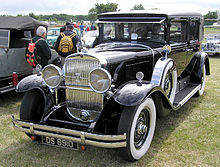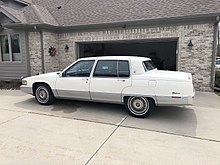Cadillac Fleetwood
| Cadillac Fleetwood | |
|---|---|
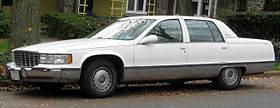 1993–1996 Cadillac Fleetwood | |
| Overview | |
| Manufacturer | General Motors |
| Production | 1941–1996 |
| Model years | 1977–1996 |
| Body and chassis | |
| Class | Full-size luxury car |
| Layout | Transverse front-engine, front-wheel drive (1985–1992) FR layout (1993–1996) |
| Chronology | |
| Successor | Cadillac CT6 |
The Cadillac Fleetwood is a model of luxury car that was manufactured by the Cadillac division of General Motors between 1976 and 1996. The "Fleetwood" name was previously used as a prefix on several of Cadillac's models dating back to 1935. Four door cars bearing the name "Fleetwood" generally had longer wheelbases than Cadillac's more common Series 62 and DeVille models.
Through 1984, all Fleetwood series cars were rear wheel drive. For 1985, "Fleetwood" was used on new front wheel drive models which were made through 1992. In 1987, a stretched wheelbase car was offered and named the Fleetwood 60 Special, a name which was last used in 1970 for the non-Brougham RWD Fleetwood car. During this time, the rear wheel drive cars built on the older Fleetwood platform dating from 1977 continued to be offered as "Fleetwood Brougham" (later shortened to "Brougham"). In 1993, a new rear wheel drive Fleetwood was introduced, but was discontinued after 1996.
Before 1934, all Cadillac models could be ordered with bodies built by General Motors' Fleetwood operation in Fleetwood, Pennsylvania, instead of their usual Fisher Body, and between 1935 and 1941, cars bearing the Fleetwood name were assembled there.
Pre-history 1916–1924[edit]
Lawrence P. Fisher was the Fisher brother most closely involved with Cadillac in its early years. In 1916 he joined the Fisher Body Company which had been formed by two of his brothers in 1908. Larry (as people knew him) was one of four of the seven Fisher brothers who brought Fisher Body Corporation under the General Motors umbrella in 1919. In May, 1925 Alfred P. Sloan, then the head of General Motors, appointed Fisher as Cadillac General Manager, an office he retained through 1934. Fisher immediately went to work adding exclusive, custom bodies to the Cadillac range. Thus he oversaw the purchase of the Fleetwood Metal Body Company by the Fisher Body Corporation in September, 1925.[1]
The Fleetwood Body Company of Fleetwood, Pennsylvania, was founded by Harry Urich in the nineteenth century. It began as a small community of craftsmen founded by Henry Fleetwood, Esq. of Penwortham, near Lancaster, England (the Fleetwood family flourished in England in the 17th and 18th centuries). The rich traditions of 300 years of coach-building that the Fleetwood Body Company applied to its work on cars secured for it a high reputation in automobile circles worldwide by the 1920s.[1] Coachwork was built by Fleetwood for a variety of luxury makes through 1924.
After the Fisher Body Corporation purchased the Fleetwood Body Company in 1925, Fleetwood bodies were reserved exclusively for Cadillac. By 1929 GM had purchased the remaining stock holdings of the Fisher Body Corporation and thus became sole owner of both the Fisher and Fleetwood companies.[1] From 1927 through 1934 all Cadillac series offered Fleetwood bodies as an option.[2][3]
Fleetwood title used as prefix 1935–1986[edit]
After 1934, Cadillac became more selective in offering Fleetwood bodies on its series and by 1938 the only way to obtain a Fleetwood bodied car was by buying a Cadillac Series 75 or 90, as even the Cadillac Sixty Special had a Fisher body in its inaugural year. The Fleetwood script and crest would not appear on the exterior of any Cadillac until the 1947 model year when it appeared on the rear deck lid of the Sixty Special. By 1952 it also appeared on the rear deck lid of the Series 75. In 1957 the Cadillac Series 70 Eldorado Brougham joined the Sixty Special and the Series 75 as the only Cadillac models with Fleetwood bodies although Fleetwood script or crests did not appear anywhere on the exterior of the car.[4] This marked the first time in 20 years that a Fleetwood bodied car was paired with the Brougham name.[2][3][5] When production of the Eldorado Brougham was shifted in 1959 from the Cadillac Fleetwood plant in Detroit to Pininfarina in Turin, Italy, only then did it acquire Fleetwood wheel discs[6] and doorsill moldings,[7] presumably because the design work[7] and final touches[8] were still being done by Fleetwood.
Production of the Eldorado Brougham ceased in 1961 but in 1963 the Eldorado Biarritz also became Fleetwood bodied and immediately acquired Fleetwood crests on its rear quarters[9] and Fleetwood rocker panel moldings.[8] The 1963 Eldorado Biarritz was also the first Fleetwood bodied convertible since the Cadillac Series 75 stopped offering 4-door and 2-door convertible body styles and production of the Cadillac Series 90 ceased in 1941.[2][3][5]
In 1965, the Eldorado, Sixty Special and Series 75 models were designated as Fleetwood “subseries” but this would only last through the 1972 model year and during this period there never was a separate Fleetwood series per se.[5] Fleetwood became a much more integral part of a Cadillac series name in 1977 with the introduction of the Cadillac Fleetwood Brougham and the Cadillac Fleetwood Limousine, which replaced the Fleetwood Sixty Special Brougham and the Fleetwood 75 respectively. In 1985, Fleetwood became a separate series in its own right.[3][10]
Fleetwood as sole designation 1985–1996[edit]
Front-wheel drive: 1985–1992[edit]
| First generation | |
|---|---|
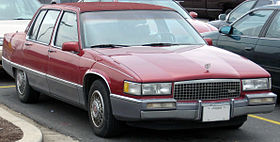 1989–1992 Cadillac Fleetwood Sedan | |
| Overview | |
| Model years | 1985–1992 |
| Assembly | Lake Orion, Michigan, U.S. |
| Designer | Irvin Rybicki |
| Body and chassis | |
| Body style | 4-door sedan 2-door coupe |
| Layout | Transverse front-engine, front-wheel drive |
| Platform | C-body |
| Related | Cadillac Sixty Special Cadillac DeVille Buick Electra Buick Park Avenue Oldsmobile 98 |
| Powertrain | |
| Engine | 4.3 L LS2 Diesel V6 4.1 L HT-4100 V8 4.5 L HT-4500 V8 4.9 L HT-4900 V8 |
| Transmission | 4-speed TH-440-T4 automatic 4-speed 4T60 automatic 4-speed 4T60E automatic |
| Dimensions | |
| Wheelbase | 1985–88: 110.8 in (2,814 mm) 1989–92 2-doors: 110.8 in (2,814 mm) 1989–92 4-doors:113.8 in (2,891 mm) |
| Length | 1985–86: 195.0 in (4,953 mm) 1987–88: 196.5 in (4,991 mm) 1989 2-door: 202.3 in (5,138 mm) 1989 4-door: 205.3 in (5,215 mm) 1990 2-door: 202.7 in (5,149 mm) 1991–92 2-door: 202.6 in (5,146 mm) 1990–92 4-door: 205.6 in (5,222 mm) |
| Width | 1985–88: 71.7 in (1,821 mm) 1989: 72.5 in (1,842 mm) 1990: 71.7 in (1,821 mm) 1991–92: 73.4 in (1,864 mm) |
| Height | 1985–89: 55.0 in (1,397 mm) 1990–92 2-door: 54.9 in (1,394 mm) 1990–92 4-door: 55.2 in (1,402 mm) |
| Curb weight | 3,500–3,900 lb (1,588–1,769 kg) |
A new front wheel drive C-body platform was introduced in 1985. The Fleetwood shared the same 110.8 inches (2,810 mm) wheelbase as the other C-body cars, the DeVille, Buick Electra, and Oldsmobile Ninety-Eight. The Fleetwood Brougham continued to use the RWD platform, (which was redesignated as "D-body" for 1985) through 1986.
As had been the case since the 1977 model year, there were little more than trim differences between the Fleetwood and the DeVille. For 1985, the Fleetwood was actually a DeVille trim option, rather than a separate model. The optional d'Elegance package, added tufted-button seating among other niceties for the FWD Fleetwood sedan. The Fleetwood coupe was dropped after the 1986 model year, but returned in 1989.
A new Cadillac Fleetwood Sixty Special model was added to the lineup for 1987 and 1988 and used a stretched 115.8 inches (2,940 mm) version of the new C-body platform, while the 1985 through 1987 Fleetwood Series 75 used a 134.4 inches (3,410 mm) stretched version of the same platform. The aluminum 4.1 L HT-4100 V8 was replaced by the 4.5 L HT-4500 for 1988. The engine displacement was increased for 1991 to the 4.9 L HT-4900.
The Fleetwood line was redesigned for the 1989 model year. To visually differentiate from the DeVilles which had also been redesigned, the upper-rung Fleetwood and Sixty Special models came with fender skirts over the rear wheels, while the DeVille had full rear-wheel openings. The Fleetwood coupe remained on the old 110.8 in (2,810 mm) wheelbase, while the sedan's wheelbase increased by 3 inches (76 millimetres). The US$30,000+ sticker prices were a bargain compared to the large German luxury cars of the time but the Fleetwoods lacked the performance and cornering/handling characteristics of the import rivals.
Power was increased to 180 hp (134 kW) from the same 4.5 L engine for 1990 through the use of a dual-stage intake manifold and other changes. It was replaced by the 200 hp (149 kW) 4.9 L HT-4900 for 1991.
The Fleetwood nameplate departed the front-drive lineup for 1993 (as Fleetwood was transferred to the new rear-drive replacement for the 1992 Brougham). Instead, the Sixty Special nameplate was used on the front wheel drive model for 1993. There were 5,292 Sixty Specials built in 1993, including 688 with the optional "Ultra" Package that featured 22-way adjustable front seats, designed in Italy by Giorgio Giugiaro. This seating package had been standard on the Sixty Special since 1989, but in 1993, it became a $3,550 option. While it was based upon the DeVille, the Sixty Special included eleven items as standard equipment, while those eleven items were optional at extra cost on DeVilles, and in addition there were options for the Sixty Special, that were unavailable on the DeVille, such as "Memory Seat" for driver with two recall settings, an "Exit" button" when pushed automatically powered the driver seat all the way rearward, and dual front seat power recliners.
Both the Fleetwood and DeVille were coded as C-bodies in the fourth digit of the VIN. The fifth digit coded the DeVille as "D" (with the later Touring Sedan becoming "T"), the Fleetwood as "B", and the Fleetwood Sixty Special as "S". The Sixty Special became the "G" code for 1991, and switched back to "B" for its 1993 run.
Transmissions:
- 1985–1986 THM440 T4
- 1987–1989 4T60
- 1990–1992 4T60E
| Displacement | Power | Torque |
|---|---|---|
| 263 cu in (4.3 L) LS2 V6 | 85 hp (63 kW) | |
| 250 cu in (4.1 L) HT-4100 V8 | 135 hp (101 kW) | 190 lb⋅ft (258 N⋅m) |
| 273 cu in (4.5 L) HT-4500 V8 | 155 hp (116 kW) | |
| 273 cu in (4.5 L) HT-4500 V8 | 180 hp (134 kW) | |
| 300 cu in (4.9 L) HT-4900 V8 | 200 hp (149 kW) | 275 lb⋅ft (373 N⋅m) |
Rear-wheel drive 1993–1996[edit]
| Second generation | |
|---|---|
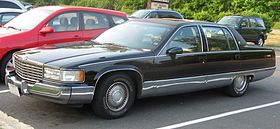 1993–1996 Cadillac Fleetwood Sedan | |
| Overview | |
| Model years | 1993–1996 |
| Assembly | Arlington, Texas, U.S. |
| Designer | Chuck Jordan |
| Body and chassis | |
| Body style | 4-door sedan |
| Layout | FR layout |
| Platform | D-body |
| Related | Buick Roadmaster Chevrolet Caprice Chevrolet Impala SS Oldsmobile Custom Cruiser Cadillac Deville |
| Powertrain | |
| Engine | 5.7 L L05 V8 5.7 L LT1 V8[11] |
| Transmission | 4-speed 4L60 automatic 4-speed 4L60E automatic |
| Dimensions | |
| Wheelbase | 121.5 in (3,086 mm) |
| Length | 225.0 in (5,715 mm) |
| Width | 78.0 in (1,981 mm) |
| Height | 57.1 in (1,450 mm) |
| Curb weight | 4,600–4,700 lb (2,087–2,132 kg) |
| Chronology | |
| Predecessor | Cadillac Brougham |
For 1993, the Fleetwood name (and exterior) was switched from the DeVille's front wheel drive C-body to the newly revised rear wheel drive D-body that the Cadillac Brougham had used previously. It was one of the first American front wheel drive vehicles to be returned to rear-wheel drive. At 225 inches (5,700 mm) overall, the Fleetwood was the longest production car made in the United States.[12] All Fleetwoods [except for the commercial chassis] had standard antilock brakes, traction control, and dual front airbags.In 1994, Cadillac used the Corvette-derived LT1[13] 350 cu in (5.7 L) engine to make 260 horsepower (190 kW) along with the new 4L60E automatic transmission.[11] Between 1993 and 1996, the Fleetwood commercial chassis was used instead of the DeVille for most funeral coaches and limousines produced during these years. The DeVille was used again in 1997, after production of the Fleetwood ceased. After 1996, the Cadillac Fleetwood was retired by General Motors along with all other rear-wheel drive sedans and the assembly plant was converted to truck production for the Chevrolet Suburban and Tahoe because of the increasing demand for SUVs.[12]
Packages
The Brougham option package included a full vinyl top, C-pillar badging, specific seat design with six-way driver's seat memory and heated and three-position lumbar front seats, instrument panel badging and rear seat storage armrest.
The 7,000 lb (3,200 kg) trailer towing package was made available 1993, a return to production sedan since the 1971–1976 Cadillac Sixty Special[citation needed]. The RPO V4P package included heavy duty cooling (RPO V08, which consisted of a seven-blade mechanical primary fan, a heavy-duty electrical secondary fan, and an extra capacity radiator), RPO FE2 Suspension System Ride Handling, HD 4L60 transmission, RPO KC4 Cooling System Engine Oil, RPO KD1 Cooling System Transmission Oil, RPO KG9 140 amp alternator, and RPO GT4 3.73 gears with an 8.5-inch ring gear. In 1994–1996, the V4P package was revised with RPO GU6 3.42 gears with the new more powerful RPO LT1 260 hp (194 kW) V8, and HD 4L60E transmission with revised accumulators to shift smoother with the shorter rear axle gearing.
Transmissions:
- 1993 4L60
- 1994–1996 4L60E
| Displacement | Power | Torque |
|---|---|---|
| 350 cu in (5.7 L) L05 V8 | 185 hp (138 kW) | 304 lb⋅ft (412 N⋅m) |
| 350 cu in (5.7 L) LT1 V8 | 260 hp (194 kW) | 330 lb⋅ft (447 N⋅m) |
| Year | Units |
|---|---|
| 1993 | 31,773 |
| 1994 | 27,473 |
| 1995 | 16,180 |
| 1996 | 15,109 |
| Total Production = 90,535 | |
References[edit]
- ^ Jump up to: a b c "Cadillac Terms and Definitions D - G". Cadillacdatabase.net. Archived from the original on 2012-01-11. Retrieved 2011-12-31.
- ^ Jump up to: a b c Kimes, Beverly (1996). Standard Catalog of American Cars 1805-1942. Krause publications. ISBN 0-87341-428-4.
- ^ Jump up to: a b c d Gunnell, John (2005). Standard Catalog of Cadillac 1903-2005. Krause publications. ISBN 0873492897.
- ^ "Mark II Meets Eldorado Brougham". Special Interest Autos (#2 Nov.–Dec. 1970).
- ^ Jump up to: a b c Kowalke, Ron (1997). Standard Catalog of American Cars 1946-1975. Krause publications. ISBN 0-87341-521-3.
- ^ "1957-1960 Cadillac Eldorado Brougham - page 5". auto.howstuffworks.com. Retrieved 2012-03-26.
- ^ Jump up to: a b "1957-1960 Cadillac Eldorado Brougham - page 6". auto.howstuffworks.com. Retrieved 2012-03-26.
- ^ Jump up to: a b Bonsall, Thomas (2003). The Cadillac Story. Stanford University Press. ISBN 0-8047-4942-6.
- ^ "Cadillac photos - 1963". Cadillacdatabase.net. Retrieved 2011-12-31.
- ^ Flammang, James (1999). Standard Catalog of American Cars 1976-1999. Krause publications. ISBN 0-87341-755-0.
- ^ Jump up to: a b Haukap, Anthony. "1993-96 Cadillac Fleetwood Brougham". Archived from the original on 2012-08-20. Retrieved 2010-10-23.
- ^ Jump up to: a b Auto Editors of Consumer Guide (March 28, 2007). "1990-1999 Cadillac - The Cadillac Brougham and Fleetwood of the 1990s". auto.howstuffworks.com. Retrieved January 14, 2018.
- ^ "1996 Cadillac Fleetwood Brougham". The Auto Channel. Retrieved 2010-10-21.
- ^ The Encyclopedia of American Cars, 2006 Edition
- Arthur St. Antoine (April 1989). "Cadillac Fleetwood Road Test". Car and Driver. 34 (10): 55–61.
External links[edit]
| Wikimedia Commons has media related to Cadillac Fleetwood. |
| show |
|---|
| show « previous — Cadillac vehicle timeline, 1980s–present
|
|---|
